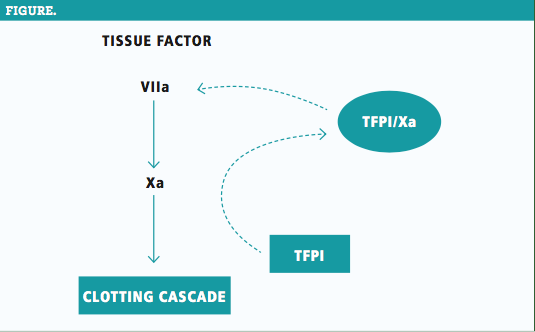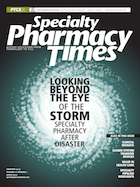Publication
Article
Specialty Pharmacy Times
Emerging Therapies for Hemophilia A and B
Author(s):
Although the leading treatment for hemophilia is a replacement therapy in the form of both plasma-derived and rF products, research is underway for the discovery of novel agents.
Hemophilia can be briefly defined as an inherited congenital coagulation disorder found in blood. There are 2 types of hemophilia, which are based on deficiencies of the blood clotting factors: Hemophilia A results from a deficiency in factor VIII (FVIII) and hemophilia B results from a deficiency in factor IX (FIX).
Hemophilia A is the most common form of the disease, affecting 80% to 85% of all patients with hemophilia, and is found in approximately 1 in 5000 male births.1 FVIII and FIX are crucial to the coagulation process of blood, which is caused when a strong platelet plug, covered by a stable fibrin clot, forms in damaged blood vessels to stop bleeding. When there is a lack of clotting factor proteins, weak platelet plugs are formed along with incomplete, possibly delayed, fibrin clots. This can result in continued bleeding from the damaged blood vessels.
Hemophilia is generally classified as mild, moderate, or severe. These classifications are made according to the level of FVIII or FIX found in the blood. Hemophilia is determined to be severe when there is less than 1% of endogenous clotting factor levels found in the blood. This will cause a patient to suffer joint bleeding that is accompanied by bleeding without any apparent injury, usually once or twice per week. Moderate hemophilia presents 1% to 5% of normal clotting factor levels and is associated with bleeding without a causal injury at least once per month. Mild hemophilia presents 5% to 40% of normal clotting factor levels and is associated with only minor bleeding problems, typically as a result of an injury and rarely including any obvious joint bleeding.2
Treatment Approaches and Emerging Therapies
Treatments for hemophilia began to emerge in the 1930s after it was discovered that human blood could be separated into its constituent parts, specifically plasma and red blood cells.3 Plasma contains FVIII and FIX along with proteins (albumin, gamma globulin, and anti-hemophilic factor), minerals, salts, sugars, fats, hormones, and vitamins. Therefore, the frozen plasma that could be extracted fresh from human blood samples became the earliest treatment method for hemophilia A and B. This collected plasma was used as direct replenishment for patients with a known condition of diminished clotting factor levels.
After the discovery of fresh frozen plasma (FFP), a breakthrough method, cryoprecipitate, was developed by Judith Graham Pool, PhD in 1964.2 Cryoprecipitated plasma was used to prepare FVIII, fibrinogen, von Willebrand factor, and factor XII from FFP. Dr. Pool’s method for this collection helped advance the use of factor concentrates, which were freeze-dried clotting factors kept as powder (quite easier for storage) and reconstituted prior to administration to patients.
Today, treatment for hemophilia focuses on replacement therapy. Conventional replacement therapy is the process of replenishing the deficiencies of clotting factors by using clotting factor concentrates.4 Treatment for severe hemophilia has shifted from primarily the management of acute episodes of patient bleeding to treatment by prophylaxis, with the introduction of recombinant clotting factor products. Mild to moderate hemophilia is generally managed with clotting factor products during acute bleeding episodes only. Extended half-life products readily allow for prophylaxis treatment and, furthermore, a decreased need for intravenous administration. Additionally, clotting factor products can be either derived from plasma or a recombinant, based on their method of manufacturing. The recombinant factor (rF) products are genetically engineered and allow for unlimited production of blood products. Eptacog alfa (NovoSeven) is a recombinant factor VIIa (FVIIa) product most commonly used for bleeding events in patients with hemophilia A and hemophilia B, along with inhibitors.
Several complications can arise with replacement therapy, however,1 including the development of neutralizing antibodies (inhibi- tors) that attack the clotting factor in blood, viral infections from natural clotting factors, and damage to joints, muscles, or other parts of the body resulting from delays in treatment.4
Inhibitors develop in about 20% to 30% of people with hemophilia A and 2% to 5% with hemophilia B.4 Furthermore, patients who develop inhibitors due to clotting factors have a worse morbidity rate than patients with hemophilia who do not develop inhibitors.1 Therefore, researchers are studying new ways to target inhibitors by both developing treatments that do not cause inhibitors and using natural inhibitors as molecular drug targets.1
Hemophilia researchers are now targeting the tissue factor pathway inhibitor (TFPI) as a novel therapeutic agent. TFPI is a reversible Kunitz-type serine protease inhibitor of factor Xa (FXa), associated with the inhibition of FVIIa-tissue factor (TF) complex via a FXa-TFPI complex (FIGURE).5

TFPI consists of 3 domains: domain 1 binds to the FVIIa-TF complex, domain 2 binds to activated FXa, and domain 3 interacts with protein S.1 Concizumab (Novo Nordisk), a human monoclonal antibody against TFPI, is being evaluated in phase 2 clinical trials (ClinicalTrials.gov identifier: NCT03196284] in patients with hemophilia A and hemophilia B.1,6
Concizumab inhibits domain 2 of TFPI and prevents the binding of FXa to TFPI.1 This results in enhanced hemostatic activity of the FVIIa-TF complex and leads to more stable clot formation and the subsequent lessening of hemophiliac bleeding events.1 The major advantages of concizumab are its subcutaneous mode of administration and substantially longer half-life. Extended half-life hemophilia treatments allow for fewer infusions and adverse events while maintaining the same therapeutic outcomes. Conversely, another monoclonal antibody similar to concizumab, BAY1093884 (Bayer Healthcare), has been developed to target domains 1 and 2 of TFPI. Recruitment is ongoing for a phase 1 clinical trial (ClinicalTrials.gov identifier: NCT03481946) that aims to assess the pharmacokinetics and pharmacodynamics of BAY1093884 on TFPI activity.7
Other emerging therapies include non-factor replacement products. These are generally bispecific antibodies that mimic the clotting factors, such as FVIII (emicizumab [Hemlibra]), while inhibiting anti- thrombin and/or TFPI.
Lastly, gene therapy is being researched as a potential cure for hemophilia. Although gene therapy has not been developed to the point where it is an acceptable hemophilia treatment, the FDA granted a breakthrough therapy designation on October 26, 2017, for BioMarin Pharmaceutical’s valoctocogene roxaparvovec (formerly BMN270), used for hemophilia A treatment.8
Valoctocogene roxaparvovec utilizes an adeno-associated virus vector serotype FVIII vector, which contains a codon optimized BDD-FVIII cassette, called BMN270, a known gene that makes FVIII so the body can make its own functional FVIII).1 Phase 3 (ClinicalTrials.gov identifier: NCT03370913) clinical trials are currently underway to assess the drug’s efficacy and safety profiles.9
Novel Hemophilia A Treatment: Emicizumab (Hemlibra)
Emicizumab (Hemlibra, Genentech) is a novel agent that was granted a breakthrough therapy designation for hemophilia A on April 16, 2018.10 Emicizumab is a bispecific monoclonal antibody used for routine prophylaxis in adult and pediatric patients with or without hemophilia A with FVIII inhibitors.1 The approval for emicizumab was assessed from both the HAVEN 1 (adult and adolescent) and HAVEN 2 (pediatric) clinical trials.11,12 The most common adverse drug reactions from the administration of emicizumab are injection site reactions, headache, and arthralgia.13
Adjunct Therapies
Hemophilia treatment methods depend on the severity of the disease, daily activities of the patient, and the probability of any future surgeries or procedures. Although replacement therapy remains the mainstay for hemophilia prophylaxis and treatment, other therapies can be used. These options include desmopressin (DDAVP), antifibrinolytic agents (tranexamic acid and epsilon aminocaproic acid), pain medicine, steroids, and physical therapy (used in conjunction with replacement therapy).4
DDAVP is a synthetic analogue of the natural pituitary hormone known as 8-arginine vasopressin.14 DDAVP stimulates the release of stored FVIII and von Willebrand factor, making this a viable treatment option for patients with a mild classification of hemophilia A.4 Antifibrinolytic agents are most often used with replacement therapy. These agents are typically administered prior to minor surgeries, such as dental procedures, to prevent bleeding events.
Conclusion
Although the leading treatment for hemophilia is a replacement therapy in the form of both plasma-derived and rF products, research is underway for the discovery of novel agents. These agents utilize different molecular drug targets, genes, and proteins involved in the process of a clotting cascade. The results are promising and have generated reasonable optimism that a pathway toward a cure for hemophilia may exist in the near future.
References
- Balkaransingh P, Young G. Novel therapies and current clinical progress in hemophilia A. Ther Adv Hematol. 2018;9(2):49-61. doi: 10.1177/2040620717746312.
- Hemophilia of Georgia. The Hemophilia, von Willebrand Disease & Platelet Disorders Handbook. https://www.hog.org/handbook/article/1/3/severity-levels. Accessed August 13, 2018.
- Patek AJ, Taylor FHL. Hemophilia. II. Some properties of a substance obtained from normal human plasma effective in accelerating the coagulation of hemophilic blood. J Clin Invest. 1937;16(1):113-124.
- National Heart, Lung, and Blood Institute. Hemphilia. NHLBI website. www.nhlbi.nih.gov/health-topics/hemophilia. Accessed August 13, 2018.
- Peyvandi F, Garagiola I, Biguzzi E. Advances in the treatment of bleeding disorders. J Thromb Haemost. 2016;14(11):2095-2106. doi: 10.1111/jth.13491.
- A Trial Evaluating the Efficacy and Safety of Prophylactic Administration of Concizumab in Haemophilia A and B Patients With Inhibitors. clinicaltrials.gov/ct2/show/NCT03196284. Accessed August 13, 2018.
- A Study to Assess Pharmacokinetics and Pharmacodynamics Following Administration of BAY1093884 in Patients With Severe Hemophilia. clinicaltrials.gov/ct2/show/NCT03481946. Accessed August 13, 2018.
- FDA grants breakthrough therapy designation for BioMarin’s valoctocogene roxaparvovec (formerly BMN 270), an investigational gene therapy for hemophilia A [press release]. San Rafael, CA: BioMarin; October 26, 2017. Accessed August 13, 2018.
- Single-Arm Study To Evaluate The Efficacy and Safety of Valoctocogene Roxaparvovec in Hemophilia A Patients. clinicaltrials.gov/ct2/show/NCT03370913. Accessed August 13, 2018.
- FDA approves emicizumab-kxwh for prevention and reduction of bleeding in patients with hemophilia A with factor VIII inhibitors. FDA website. www.fda.gov/drugs/informationondrugs/approveddrugs/ucm585650.htm. Accessed August 13, 2018.
- Oldenburg J, Mahlangu JN, Kim B, et al. Emicizumab prophylaxis in Hemophilia A with inhibitors. N Engl J Med. 2017;377(9):809-818. doi: 10.1056/NEJMoa1703068.
- A Study of Emicizumab Administered Subcutaneously (SC) in Pediatric Participants With Hemophilia A and Factor VIII (FVIII) Inhibitors. clinicaltrials.gov/ct2/show/NCT02795767. Accessed August 13, 2018.
- Hemlibra (emicizumab-kxwh) [prescribing information]. www.fda.gov/medwatch. Accessed August 13, 2018.
- DDAVPP injection (desmopressin acetate) 4 mcg/mL [prescription informaiton]. Bridgewater, NJ: Sanofi-Aventis; 2007. products.sanofi.us/ddavp_iv/ddavp_iv.pdf. Accessed August 13, 2018.







